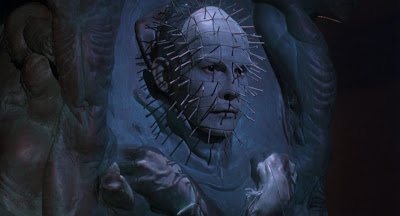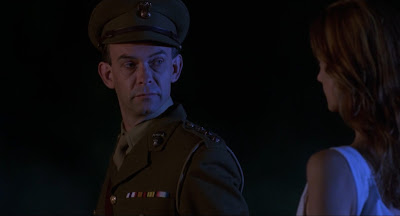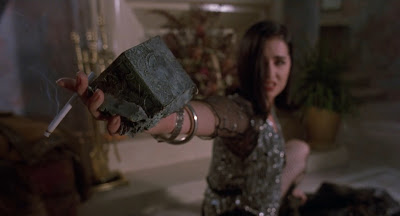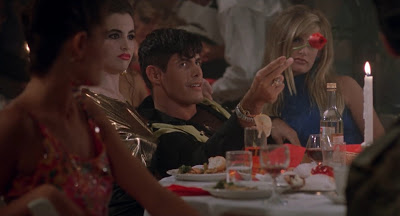 |
| Pinhead is trapped in a pillar - but not for long... |
Release Date: Sept. 11, 1992. Running Time: 91 minutes (theatrical), 93 minutes (unrated), 97 minutes (extended). Screenplay by: Peter Atkins. Story by: Peter Atkins, Tony Randel. Directed by: Anthony Hickox. Produced by: Lawrence Mortorff.
THE PLOT:
Joey (Terry Farrell) is a young New York City television reporter who has become frustrated covering fluff stories involving kindergarteners and cute animals. She wants to prove herself. To that end, she spends one night staking out an Emergency Room, growing frustrated at the lack of stabbings or shootings she can use to advance her career. Yes, this is our heroine.
Suddenly, a patient is rushed in, escorted by a frightened young woman. Chains are attached to his body. Joey follows... and watches as the chains tear the boy apart! The young woman who brought him is long gone... but not before dropping a book of matches, which leads Joey to The Boiler Room, a popular nightclub run by J. P. Monroe (Kevin Bernhardt).
Joey goes to the club and hands out her card, telling everyone that she's looking for "a pretty girl... really pretty." Which sounds less like she's following a lead on a story than like she's looking for a date, but she somehow succeeds in connecting her with her target: J. P.'s ex-girlfriend, Terri (Paula Marshall), who reveals that the chains came out of a puzzle box that was swiped from a bizarre statue belonging to J. P.
Joey lets her stay at her insanely luxurious condo (maybe she really was looking for a date) while they investigate the puzzle box. Meanwhile, J. P. manages to cut himself and bleed onto the pillar, which is enough to wake up Pinhead (Doug Bradley). The demon needs more blood in order to free himself and recover his former strength - and with a little bit of persuasion, J. P. is more than happy to help!
 |
| Joey (Terry Farrell) confronts Pinhead. |
CHARACTERS:
Joey: I'm a fan of Deep Space 9, so I know that given decent material, Terry Farrell can act. Unfortunately, she doesn't receive any decent material. There's an acceptable starting point for a character, with Joey struggling to be taken seriously despite her youth and the quiet misogyny that has an editor advising her to show "more thigh." But all of that disappears after about the thirty-minute mark, leaving the main character an almost total blank slate... one with an implausibly large condo for New York City. Even in 1992, a struggling cub reporter would be living out of the equivalent of a walk-in closet - not a condo with two stories, two-bedrooms, a full living room, and a kitchen!
Terri: I think writer Peter Atkins missed a trick by not making Terri the main character. Unlike Joey, she is directly connected to J. P., the club, and the pillar. She's also a much better realized character. She's someone who's screwed up her young life at every turn with bad choices and worse boyfriends, but she retains basic decency: She gets pulled into this story precisely because she stopped to help the ill-fated young man rather than leaving him to his fate. Paula Marshall puts some effective nonverbal beats into her performance, coming across as constantly anxious. She fidgets nonstop even as she tells Joey how much she loves it at her place, likely already fearing that this temporary haven will be taken from her.
J. P. Monroe: As slick as he is insincere, J. P. (Kevin Bernhardt) doesn't even try to deny his nature. He shamelessly flirts with girls at his club, wooing the ones who catch his eye with a red rose and pick-up lines that would likely be rejected by even the naivest of young coeds. He appeals to Terri not by pretending to be something he's not, but instead by saying, "I'm a bad guy, but I try not to be." Only the first part of his statement is actually true, as shown by how little persuasion it takes for him to agree to find victims for Pinhead.
Kirsty: Ashley Laurence appears very briefly courtesy of some grainy video footage, interviews apparently filmed during Kirsty's stay at the Channard Institute. This tie to the first two movies is welcome, but it also highlights how much was lost with this entry's change of direction.
 |
| Elliot Spencer, Pinhead's human half, appeals to Joey for help. |
DOUG BRADLEY AS ELLIOT SPENCER AND PINHEAD:
Doug Bradley is this movie's saving grace. He pulls double duty as Pinhead (actually called that on screen for the first time) and as his human half, Capt. Elliot Spencer.
Though Elliot is characterized in heroic terms and Pinhead in demonic ones, they really are two sides of the same person. This is most evident in their love of words. "A dream of one war is a dream of all wars," Elliot tells Joey as they walk through his memories of World War I trenches. As he imparts exposition, he finds time to add observations about how the war shaped his generation: "The war pulled poetry out of some of us... We'd seen God fail, you see. So many dead. For us, he too fell at Flanders."
All of this builds up to him persuading Joey to help him defeat his demon side, at great risk to her own life. He gains her trust, provides information, and convinces her not only that his goals need to be achieved but that she is up to the challenge.
Which is exactly what Pinhead does with J. P.! He forges a bond and reveals information - specifically, that he can see the dark deeds the younger man has committed. He expresses empathy for J. P.'s murder of his parents: "Their fortune was so tempting, their affection so conditional." He appeals to the other man's love of dark-themed artworks: "Look at your paintings, your sculptures. Look at these tawdry representations and then imagine... Your will and mine as the brush and the knife." By the end of the conversation, he has convinced J. P. that he both can and should help him.
 |
| Terri (Paula Marshall) reveals the puzzle box. |
VERSIONS:
There are multiple versions of Hellraiser III. The major variants are: the 91-minute US theatrical version; the 93 minute "unrated" cut, which restores and expands some of the sex and violence; and the 97 minute "extended" version, released alongside the unrated cut on Arrow Video's Blu-ray set.
The extended cut retains all of the unrated version's expansions, and also adds a handful of additional bits. The new material is easy to spot, presented in full frame and of noticeably lower quality than the rest of the movie. None of the additions amount to much: A couple of extra shots, including a gratuitous breast flash, in the nightclub; a would-be atmospheric moment in a diner, with J. P.'s face reflected in Terri's coffee cup; some close-ups of dead soldiers in the World War I scene. The most interesting addition sees Elliot walking Joey through the Indian bazaar where he purchased the box. Unfortunately, it's shot in an awkward close-up, probably to hide the cheapness of the set, which I suspect is why it was removed in the first place.
Though the extended cut is an interesting curio, none of this added footage really contributes anything. In the end, I'd pick the 93-minute version as the best presentation of this movie.
 |
| J. P. Monroe (Kevin Bernhardt): slick and sleazy. Also shallow and rather boring. |
OTHER MUSINGS:
The first two Hellraiser movies proved to be box office successes, with grosses that far outstripped their modest budgets. A third film was all but inevitable - and after a short delay caused by the bankruptcy of New World, the US studio that helped finance the first installments, it eventually happened - with a few changes.
There was interest in making a Hellraiser movie with more appeal to mainstream (young) horror audiences. Gone are characters in their (*gasp*) forties, with all the new characters being in their early twenties. Also gone are the Gothic atmosphere and dark fantasy overtones. The Elliot Spencer trench sequence provides a postcard glimpse of the kind of world building the first two films did; but it's only a glimpse, and the surrounding movie is basically your standard Hollywood slasher in tone, style, and structure.
Outside of Pinhead's scenes, most of the first half is shockingly dull. Joey and Terri investigate the box... but those of us who have seen the first two movies already know what it is and what it does, and there are no expansions on the lore here. Instead of being intrigued by the mystery, we're left waiting for the characters to catch up with the audience.
Nor are there any interesting character dynamics. There's no sense of a nascent friendship between Joey and Terri. Terri is surprised when, after she's shared all the information she knows, Joey offers to let her stay in her spare bedroom. Honestly so was I. Some sitcom shenanigans involving a burnt breakfast provide their only real bonding moment in the entire movie!
I was being sarcastic in my "looking for a date" comments - but honestly? The first half would be more interesting and make entirely more sense if Joey actually was infatuated with Terri.
 |
| Pinhead goes to church and even delivers the guest sermon. Now I want a sequel where he goes full-on televangelist... |
A CLUB AND A CHURCH:
The last half hour unleashes Pinhead. At this point, it abandons any pretense of being anything other than a slasher flick. But at least the pace picks up, and this final Act benefits from two terrific set pieces.
First comes a massacre in a nightclub. It opens by showing the clubgoers enjoying their night out, oblivious to the transformations occurring around them. Then the violence begins: A few isolated bits at first, mainly to draw the attention of the crowd and to build their fear. Pinhead appears, and he seems to bask in his victims' mounting terror. "Shall we begin?" he asks. Then the killings go into overdrive even as the hapless youngsters try to flee. The sequence ends on the closed door to the club, with the sounds of screams on the others side. Blood seeps from under the door, and the screams are cut off one by one, until it finally ends on the silent spectacle of the ever-growing pool of blood.
The second set piece takes place in a church - or rather, the recreation of a church, as no church was willing to allow the scene to be shot there. Pinhead mocks a priest who tries to ward him off with a crucifix. He recites Scripture - "Thou shall not bow down before any graven image" - and melts the crucifix in the man's hand. He then strikes a Christ pose behind the altar while standing before the stained glass, cackling as it explodes in the movie's most memorable visual.
OVERALL:
It's hard to credit this as sharing DNA with the moody 1987 original. This is the film that marks the start of the series' decline, embracing shallow horror thrills over atmosphere or complex themes.
It's good enough for what it is, and it gets a big boost from Doug Bradley's performance and from those two Third Act set pieces. Even so, this is the least ambitious theatrically released Hellraiser. It would require only the smallest of rewrites to revamp this into the latest "nightmare" for Freddy Krueger, as it shares more in common with that series than with Clive Barker's dark fantasy works.
If you enjoy the genre, you'll likely have a good enough time. But if you skip it, you won't be missing anything.
Overall Rating: 5/10.
Previous Movie: Hellbound - Hellraiser II
Next Movie: Hellraiser - Bloodline
Review Index
To receive new review updates, follow me:
On Twitter:
On Threads:
No comments:
Post a Comment